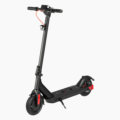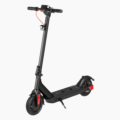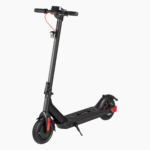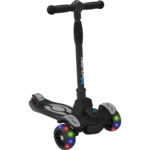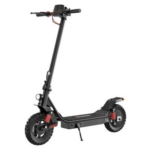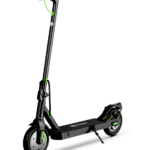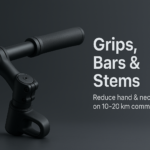- Home
- Scooters
- Electric Scooters
- TurboAnt X7 Max
TurboAnt X7 Max
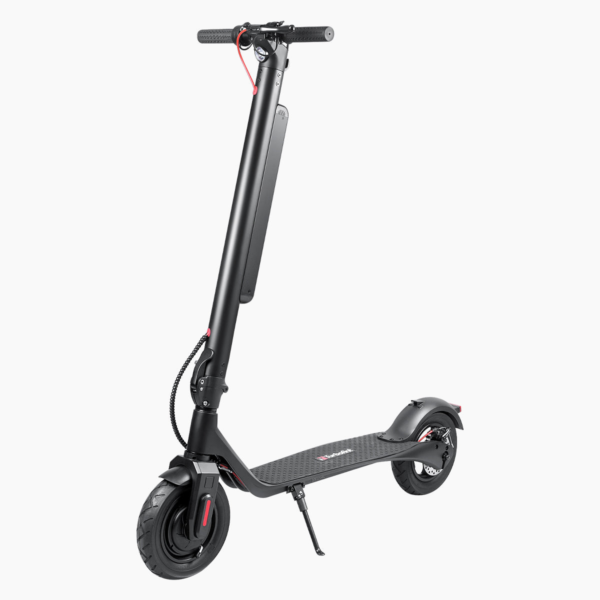


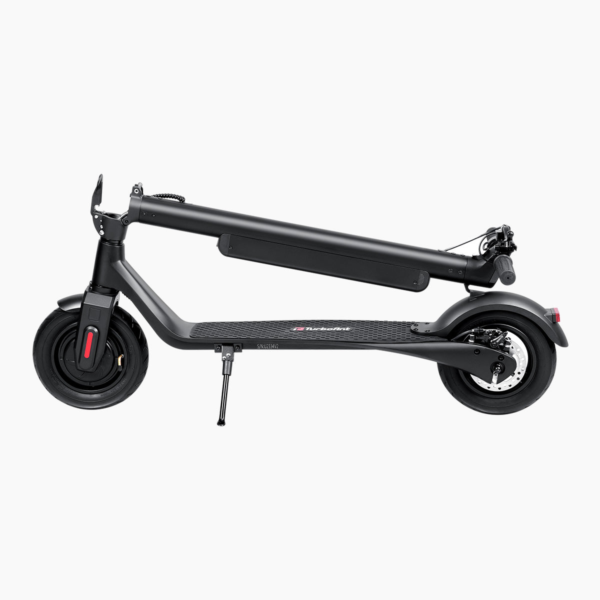
- Battery Range: 32 miles (51 km)
- Top Speed: 20 mph (32 km/h)
- Motor Power: 350 W
- Weight Capacity: 275 lb (125 kg)
- Charging Time: ~6 h
- Scooter Weight: 34.2 lb (15.5 kg)
PROS
- Removable battery design
- 10″ pneumatic tires
- 20 mph (32 km/h) top speed
- Rear disc + electronic braking
- Higher 275 lb (125 kg) load
- IPX4 water resistance
CONS
- No suspension
- Basic display; no app
- Front-wheel drive can slip on steep hills
- Heavier than many entry models
Table of contents
- What Is the TurboAnt X7 Max?
- How the TurboAnt X7 Max Works
- Key Specifications (clean table)
- Design & Build Quality
- Performance Fundamentals
- Battery, Range & Efficiency
- Ride Quality & Comfort
- Braking & Safety Features
- Portability & Daily Usability
- Maintenance & Care
- Weather & Seasonal Considerations
- TurboAnt X7 Max vs Alternatives
- Who the TurboAnt X7 Max Is (and Isn’t) For
- FAQs
- Glossary
- Extended Guidance for Owners
- The Case for the TurboAnt X7 Max
- Key Takeaways
- Final Notes on Official Info and Setup
The TurboAnt X7 Max is a practical, removable-battery commuter scooter built for everyday city travel. It favors stability, long range for its class, and straightforward controls. Because it balances comfort with portability, it suits riders who want a reliable daily tool rather than a weekend toy. It keeps things simple, yet it still feels refined on real streets.
What Is the TurboAnt X7 Max?
At its core, the X7 Max is a 10-inch-tire, single-motor electric scooter that focuses on real-world commuting. It uses a removable stem battery, a rear mechanical disc brake with front electronic braking, and a clean folding mechanism. The design is familiar, but it has thoughtful touches. You get a broad deck for stable stance, a centered display for at-a-glance info, and lighting that makes night rides more predictable. For riders who want dependable performance and low hassle, that combination matters.
How the TurboAnt X7 Max Works
Electric scooters all share a few key parts. The motor lives in the front hub on this model. It is a brushless DC unit with smooth throttle response and torque suited for stop-and-go streets. The controller is the scooter’s brain. It reads your throttle input, meters current to the motor, and blends regenerative braking with the mechanical system. Because it does the blending, the brake lever feels consistent over different speeds.
The battery sits inside the stem and is removable. That placement keeps the deck open and the center line tidy. It also lets you swap packs or charge them indoors. A spring latch secures the pack, and it seats firmly when installed correctly. The throttle is a thumb lever that ramps power in gently. Beginners appreciate that. Yet it still gives enough punch to merge into bike-lane flow. For brakes, you get a rear disc mechanism plus electronic regen at the front hub. The two systems work together and reduce stopping distances on dry pavement.
Key Specifications (clean table)
| Block | Details |
|---|---|
| General | Class: Commuter e-scooter; Frame: aluminum alloy; Tire size: 10 in pneumatic; Suspension: none; Water resistance: IPX4; Max rider load: 275 lb (125 kg); Net weight: ~34 lb (≈15.5 kg); Speed modes: 3 |
| Performance & Power | Front hub motor: 350 W nominal (peak higher); Top speed: up to 20 mph (32 km/h) where permitted; Typical gradeability: up to ~15% with a light rider on smooth pavement; Throttle: right-thumb |
| Battery, Charging & Electrical | Pack: 36 V, 10 Ah removable (≈360 Wh); Charger: 42 V, 2 A; Typical charge time: about 4–6 hours; Regenerative braking: yes (front hub); Display: centered LED; Lights: front headlight and rear brake light; Side reflectors: yes |
| Build & Dimensions | Tires: 10 in pneumatic; Deck: full-length standing area with rubberized mat; Handlebars: fixed height; Unfolded (L×W×H): ≈45.3 × 16.5 × 49.2 in (≈1150 × 420 × 1250 mm); Folded (L×W×H): ≈45.3 × 16.5 × 19.3 in (≈1150 × 420 × 490 mm) |
| Safety & Control | Brakes: rear mechanical disc + electronic front regen; Bell: yes; Headlight: high-mounted; Tail/brake light: integrated; Kickstand: side; Cruise control: yes (after steady throttle) |
| Features & Extras | Removable stem battery, cruise control, three riding modes, walk-assist (low-speed push), easy folding latch, puncture-friendly 10-inch pneumatic tires |
| Warranty & Compliance | Limited warranty typical of the category (often 12 months on core components; shorter on battery/consumables); IPX4 splash resistance; Regional speed/road-use rules vary by location |
Note: Dimensions and weights are manufacturer-class figures. Minor variances can occur between production runs and measurement methods.
Design & Build Quality
The X7 Max feels purpose-built for daily use. The frame uses a simple, stiff geometry that avoids creaks when you push off. Because the deck is long and topped with a grippy rubber mat, it gives you room to stagger your feet. That stance reduces fatigue during longer rides. The deck’s edges are rounded enough that you do not catch your shoes when shifting weight.
The stem locks down with a direct, positive latch. The mechanism engages cleanly, so you do not wrestle with it on the sidewalk. Although there is no suspension, the 10-inch pneumatic tires absorb the chatter that would rattle smaller wheels. Meanwhile, the cockpit remains clean. The centered LED display summarizes speed, mode, and battery at a glance. The thumb throttle sits on the right, and the brake lever is on the left. Because the controls are clustered within easy reach, your hands settle naturally within the first block.
Fit-and-finish is consistent across visible fasteners and interfaces. Screws seat flush, the deck seam is tidy, and the cable routing down the stem is neat. The result is a scooter that looks minimal yet feels robust. It feels ready to be thrown into your day without fuss.
Performance Fundamentals
Acceleration feel
The X7 Max prioritizes smooth, predictable launches. The throttle has a gentle initial ramp, so you do not lurch forward. However, there is enough torque that you can clear intersections with confidence. In Sport mode, roll-on power from 5 to 15 mph (8 to 24 km/h) feels brisk for a commuter. That mid-range is where city riders spend most of their time. Because the controller meters current progressively, traction stays composed on painted lines and damp patches.
Cruising stability
Once at speed, the scooter tracks straight. The 10-inch tires contribute to that stability. They round off the sharp edges of cracks and joints, which helps the bars stay calm. The deck height is moderate, so your center of gravity sits where it should. As a result, lane changes feel deliberate, not twitchy. Even with no suspension, the air volume in the tires soaks up small impacts before they reach your wrists.
Hill-climb behavior (~7–10% grades)
On common city grades, the X7 Max holds momentum well for a single-motor machine. At 7% it maintains a steady pace without bogging, especially with a lighter rider. At 10% it slows, yet it keeps climbing as long as you lean forward and keep the throttle steady. Because regen reduces speed efficiently on the way down, you can control descent without dragging the rear brake constantly.
Battery, Range & Efficiency
The removable 36 V, 10 Ah battery gives this scooter its personality. Because you can charge the pack off the scooter, it suits apartment living. The rated energy is around 360 Wh. Under ideal conditions, riders can reach a long commute on one charge. Real life is different, though, and range depends on weight, temperature, hills, wind, tire pressure, and pace.
A 150 lb (68 kg) rider, cruising at neighborhood speeds on flat asphalt with warm temperatures and properly inflated tires, can achieve a long distance on one pack. Heavier riders or those facing hills and cold winds will see less. Even so, the pack remains efficient because the controller blends regen during light braking and downhill coasting. You can feel that gentle drag as you roll off the throttle. It adds a few free watt-hours back to the battery and reduces rear brake wear.
Charging with the 42 V, 2 A charger typically takes about 4–6 hours from low battery to full. Because lithium packs live longer when treated gently, consider charging to around 90% for daily use and topping up fully before long rides. Also, avoid storing the battery full or empty for weeks. Around 40–60% state of charge is a friendlier resting point for extended storage.
Ride Quality & Comfort
Ride quality depends on tires, stance, and geometry. Here, the 10-inch pneumatic tires carry much of the comfort load. They damp high-frequency buzz from textured asphalt and act like small, passive springs. Consequently, the scooter feels composed on everyday streets. You still need to avoid sharp potholes, of course, because there is no suspension to save you from deep hits.
Ergonomically, the bar width suits urban weaving without feeling cramped. The deck length allows a natural staggered stance. Because the stem is stiff, stem flex stays low at commuting speeds. That steadiness helps when braking hard or tracking over long seams. On very rough sections, you will feel the jolts through the bars, but the tire volume keeps things tolerable.
Comfort improves further if you keep tire pressure in the recommended range. Under-inflation makes the scooter feel sluggish and increases puncture risk. Over-inflation sharpens every bump. Aim for a middle ground suited to your weight. Check pressures weekly, and the ride stays predictable.
Braking & Safety Features
The braking system pairs a rear mechanical disc with front electronic regeneration. The lever feel firms up halfway through the pull, and the scooter decelerates in a straight line. On dry, clean pavement the stopping distance is short for the class. Because regen contributes at the front, the rear brake does not need heroics to slow you down. As always, keep two fingers ready over the lever in busy areas.
For visibility, the high-mounted headlight throws a steady beam at handlebar height. The tail/brake light brightens as you slow so following traffic sees you. Side reflectors add passive visibility when cross traffic approaches at night. The IPX4 splash rating means the scooter tolerates light splashes and drizzle. It is not intended for heavy rain, flooded streets, or pressure washing. Because electronics and water are uneasy companions, treat wet commutes with respect.
Finally, the cruise control engages after holding a steady speed for several seconds. It reduces finger fatigue on longer runs. Tap the brake or nudge the throttle, and it disengages instantly.
Portability & Daily Usability
Daily commuters value convenience. The X7 Max folds quickly. The stem latch engages with a solid click, and the folded package lies flat. At around 34 lb (≈15.5 kg), many riders can carry it up a short flight of stairs without strain. It fits under most office desks or into a car trunk. Because the battery is removable, you can lighten the carry by separating it, or charge the pack indoors while leaving the scooter in a garage.
In crowds, the scooter remains maneuverable at walking speeds. The walk-assist feature helps you push it gently without jumping onto the throttle. The kickstand deploys easily, so quick stops are painless. For storage, choose a dry, temperate spot. Heat accelerates battery aging, and deep cold reduces range temporarily. A room-temperature closet usually works fine.
Security matters, of course. Use a decent lock through the frame and a fixed object. Bring the battery inside when possible. Record the serial number and keep photos of the scooter for your records. Good habits reduce the chance of loss.
Maintenance & Care
Electric scooters ask for less care than bicycles, yet they still appreciate routine attention. Here is a simple schedule that keeps the X7 Max feeling fresh:
- Before every ride: Quick visual check. Squeeze the brake lever and ensure solid feel. Confirm the latch is fully closed. Scan the tires for cuts or low pressure.
- Weekly: Check tire pressure and inflate to the recommended range for your weight. Wipe the deck and handlebar area. Confirm all lights work.
- Monthly: Inspect brake pad wear and caliper alignment. If braking feels spongy or noisy, adjust the cable tension and caliper position. Verify all visible fasteners are tight, including stem bolts and axle nuts. A quarter-turn can stop a rattle from growing.
- Quarterly: Clean and lightly lube pivot points on the folding latch. Examine the battery contacts for dust and wipe with a dry cloth. Review any available firmware notes and apply updates if provided for your unit.
- Annually: Replace worn brake pads and evaluate tire tread. If your commute includes glass-strewn streets, consider adding puncture-resistant liners or higher-quality tubes.
As with any device, defer to the manufacturer’s maintenance guidance. Also, follow safe charging habits: use the original charger, avoid covered charging, and keep the pack on a stable, non-flammable surface.
Weather & Seasonal Considerations
Weather affects grip, range, and comfort. In rain, tire contact patches shrink and painted lines become slick. Therefore, reduce speed and increase following distance. Brake earlier and with lighter inputs. Because the X7 Max has an IPX4 splash rating, plan for wet sidewalks but avoid deep puddles, flooded underpasses, and heavy downpours. Water pooled above the deck level risks ingress.
In heat, lithium batteries warm up faster. Store the scooter out of direct sun when parked. If the deck and stem feel hot, let them cool before charging. In cold, range drops because chemical reactions slow down. Expect a noticeable decrease below 50°F (10°C), and a significant one near freezing. Pre-warm the battery indoors when possible, and keep rides smooth rather than full-throttle sprints.
Seasonal tips help too. In autumn, leaves hide potholes and get slick when wet. In winter, salt and slush attack metal parts; wipe the scooter after rides and dry it before storage. In spring, streets gather grit that extends braking distances. Adjust your pace accordingly.
TurboAnt X7 Max vs Alternatives
Commuter scooters fall into rough families. The X7 Max sits in the removable-battery commuter niche. That gives it a few distinct advantages. First, you can charge and store the pack separately. That helps apartment dwellers, office workers, and anyone who splits time between locations. Second, pneumatic 10-inch tires deliver comfort without the complexity of budget suspension units. Third, the weight remains manageable for short carries.
Compared with entry-level commuters, the X7 Max offers more range and a steadier ride at speed. It also feels better built around the folding latch and deck interface. Against performance commuters, it cannot match raw acceleration or top speed. Yet it wins on portability, friendliness, and value per mile. Finally, versus off-road-leaning scooters, it is far more compact and easier to live with daily. However, it is not meant for rough trails, big roots, or sand. Choose the tool that matches your surfaces.
If you need a light, long-range city scooter with a removable battery, the X7 Max remains compelling. If you chase top-end speed, dual motors, or hydraulic brakes, a heavier class will fit better. Knowing your route and constraints helps you decide.
If you’re comparing commuter options in this class, our Hover-1 Stealth review highlights a lighter, entry-friendly benchmark to weigh against the X7 Max.
Who the TurboAnt X7 Max Is (and Isn’t) For
This scooter shines for commuters, students, and last-mile riders who value consistency. It is easy to learn, easy to fold, and easy to charge indoors. Multi-modal travelers who jump between bus, rail, and sidewalk will appreciate the size and weight. Neighborhood errands and short cross-town hops fall squarely within its wheelhouse.
It is less ideal for riders who want aggressive acceleration or serious hill dominance. Mountain towns and very steep neighborhoods ask more of a single-motor commuter. Likewise, if you demand suspension for cobblestone or broken asphalt, you will want a different design. Still, for the most common urban and suburban tasks, the balance here hits the sweet spot.
For distance-based picks and practical tips, see the best electric scooters for commuting (5–20 km daily) guide.
FAQs
1) Is the battery on the X7 Max removable, and how secure is it?
Yes. The stem battery detaches for charging or swapping. It locks into place with a firm latch, and it does not rattle when seated properly.
2) What real-world range can riders expect?
Range varies with rider weight, terrain, temperature, wind, and speed. Lighter riders on flat routes see long distances. Heavy riders on hilly, cold routes will see less. Plan with a little margin.
3) How fast is the X7 Max?
It reaches up to 20 mph (32 km/h) in unrestricted mode where local rules allow. Always follow the speed laws in your area.
4) How does the X7 Max handle hills around 7–10%?
It climbs steady grades reliably, though speed drops on 10% slopes. Lean forward, keep momentum, and let the controller deliver consistent torque.
5) What type of brakes does it use?
A rear mechanical disc brake works with front regenerative braking. The combination offers a predictable lever feel and strong, straight-line stops.
6) Does it have cruise control and is it safe to use?
Yes. Cruise engages after you hold a steady speed for a few seconds. It disengages immediately when you touch the brake or adjust the throttle. Use it on open paths, not in crowds.
7) Where can I find a concise TurboAnt X7 Max overview?
You are reading it. This article summarizes the scooter’s purpose, strengths, trade-offs, and maintenance essentials in one place.
Glossary
- Ah (ampere-hour): Battery capacity measure; higher Ah usually means longer range, all else equal.
- Wh (watt-hour): Energy measure (volts × amp-hours); useful for comparing range potential.
- Brushless motor: Efficient electric motor with no brushes; common in e-scooters for durability and low maintenance.
- Controller: The electronic unit that interprets throttle and brake signals and regulates motor power.
- Regen (regenerative braking): System that converts some kinetic energy back to electrical energy during deceleration.
- IP rating: Ingress Protection score; IPX4 here indicates splash resistance from any direction.
- Stem flex: The small movement you feel at the handlebar when the stem bends under load. Less flex feels more precise.
- Pneumatic tire: Air-filled tire that cushions impacts and improves grip compared with solid rubber tires.
- Deck: Standing platform; its length and grip affect comfort and stance options.
- Speed modes: Preset performance levels that cap top speed and adjust throttle response.
- Gradeability: The steepness a scooter can climb while maintaining usable speed.
- Thumb throttle: A lever you push with your thumb to control motor power; it allows fine modulation.
- Mechanical disc brake: Cable-actuated caliper clamping a rotor; reliable and serviceable.
- Fold latch: Mechanism that locks the stem upright or folded; critical to stability and portability.
- Walk-assist: Low-speed mode that helps you push the scooter without hopping on.
Extended Guidance for Owners
Pre-Ride Routine
Because small checks prevent big headaches, build a 30-second habit. Confirm the folding latch is locked. Look at the tires. Squeeze the brake lever while rolling the scooter forward a foot; it should bite promptly. Glance at the battery level and speed mode. A quick pre-ride scan avoids surprises mid-commute.
Riding Technique
Start in a lower mode if you are new. Push off lightly, then roll into the throttle. Keep your knees soft. On rough patches, shift a little weight toward the rear to unweight the front wheel. When braking, apply steady pressure instead of grabbing the lever. Because regen assists, the scooter decelerates smoothly without huge lever effort.
Battery Habits
Lithium cells prefer moderate states of charge and moderate temperature. Therefore, avoid full-to-empty cycles unless needed. If you must store the scooter for weeks, leave the battery around half full and check it monthly. Use the original charger. Place it on a non-flammable surface while charging, and give it open air.
Tire Care
Pneumatic tires are your suspension. Keep them healthy. Inspect for embedded debris and sidewall cuts. Maintain proper pressure for your weight. If you suffer frequent punctures in your city, consider thicker tubes or puncture-resistant liners. They add a little weight but can save your morning.
Brake Tuning
Cables stretch slightly over time. If the lever pull grows long, turn the barrel adjuster at the caliper or lever a half-turn at a time. Spin the wheel and confirm the rotor runs true. Replace pads when they look thin or feel glazed. A few minutes of attention restores crisp braking.
Cleaning
Wipe dirt and grime with a damp cloth. Avoid blasting water at bearings, axles, or the controller housing. Because the scooter carries an IPX4 rating, it is fine with light splashes but not with soaking. Dry the scooter before storage, especially after winter rides.
The Case for the TurboAnt X7 Max
The TurboAnt X7 Max keeps proving itself in three ways:
- Practical range for the weight. The removable 360 Wh class battery does real work without making the scooter unwieldy.
- Comfortable ride without complexity. Ten-inch pneumatic tires are simple and effective. You get comfort without springs to service.
- Low-friction ownership. The folding mechanism, cockpit, and maintenance tasks are straightforward. That matters when this becomes part of your Monday through Friday.
Of course, there are trade-offs. There is no suspension, and a single motor cannot match dual-motor punch. Yet those choices keep weight down, price reasonable, and reliability high. If those priorities match your needs, this scooter fits well.
Key Takeaways
- The X7 Max is a commuter-first scooter with a removable stem battery.
- It pairs 10-inch pneumatic tires with a robust, simple fold latch.
- A rear disc + front regen system provides predictable stopping.
- Real-world range varies with rider, route, temperature, and pace, but the battery and controller work efficiently together.
- Maintenance is light: check pressures, adjust the brake, keep fasteners snug, and charge sensibly.
- Weather is manageable with caution; avoid deep puddles and heavy downpours due to IPX4 limits.
- If you want more speed or suspension for rough roads, look at a heavier segment; otherwise, this hits a smart daily balance.
Final Notes on Official Info and Setup
When you unbox the scooter, read the quick-start sheet before the first ride. Confirm the latch’s orientation, torque the handlebar clamp bolts, and set the brake reach if needed. Then, inflate the tires to a rider-appropriate pressure. Finally, cycle the battery through a gentle first charge. Those habits help the scooter feel solid from day one.
Because this overview is built around official specifications, small changes are possible between batches. Always double-check the label on your specific unit for battery rating, tire markings, and recommended pressures. That way, you tune the scooter precisely to your hardware.
Specifications
General
| Model The Model specifies the exact version or name of the scooter. It helps identify its unique design, features, and specifications within the manufacturer’s product line. Knowing the model makes it easier to compare options, find compatible accessories, or look up support information. | X7 Max |
| Brand The Brand identifies the manufacturer or company that designs and produces the scooter. A trusted brand is a sign of quality, reliability, and good customer support. Well-known brands often have higher standards for safety, performance, and after-sales service, giving you more confidence in your purchase. | TurboAnt |
| Release Date The Release Date indicates when the scooter model was officially launched on the market. This helps you know how current the design, technology, and features are. A newer release date often means updated components, improved performance, and the latest safety or smart features. | 17 November 2025 |
| Recommended Age Recommended Age indicates the minimum age range that the scooter is designed for, based on safety, size, and ease of use. Following the recommended age helps ensure that riders can handle the scooter’s speed, weight, and controls comfortably and safely. Always check local laws and use protective gear, especially for younger riders. | 16+ |
Performance & Power
| Motor Power (Wattage) What it means: The motor power, measured in watts (W), shows how strong the scooter’s electric motor is. Why it matters: Higher wattage usually means better acceleration, more torque, and improved performance on hills or rough terrain. For example, a 250W motor is good for flat city roads and light riders, while a 500W or 1000W motor provides more power for faster speeds or climbing steep inclines. | 350 W front hub motor |
| Top Speed The Top Speed indicates the maximum speed that the scooter can reach under optimal conditions. It’s usually measured on level ground with a fully charged battery and an average rider weight. A higher top speed allows you to travel longer distances faster, but always ensure you ride within legal speed limits and your personal comfort zone for safety. | 20 mph (32 km/h) |
| Battery Capacity Battery Capacity refers to the total amount of energy the scooter’s battery can store, usually measured in ampere-hours (Ah) or watt-hours (Wh). A higher battery capacity means you can ride longer distances on a single charge, reducing the need for frequent recharging. Keep in mind that actual range can vary depending on rider weight, terrain, speed, and weather conditions. | 36 V 10 Ah (360 Wh) |
| Estimated Range per Charge The Estimated Range per Charge indicates the average distance the scooter can travel on a single full battery charge. This range is calculated under optimal conditions, such as flat terrain, moderate speed, and average rider weight. Real-world range may vary depending on riding style, terrain, weather, and load. A longer range means fewer recharges and greater freedom for longer trips. | 32 miles (51 km) |
| Hill Climb Ability Hill Climb Ability describes the maximum incline or slope that the scooter can handle while maintaining stable performance. It’s typically expressed as a percentage or in degrees. A higher hill climb rating means the scooter can tackle steeper hills without losing too much speed or power. Actual climbing performance may vary based on rider weight, battery charge, and terrain conditions. | 15% |
| Drive System The Drive System refers to how power from the motor is delivered to the wheels. Electric scooters typically use either a hub motor (directly integrated into the wheel) or a chain/belt drive system. A high-quality drive system ensures smooth acceleration, efficient power transfer, and low maintenance. The choice of drive system affects performance, noise level, and overall ride experience. | Front hub (FWD) |
Charging & Electrical
| Charging Time Charging Time indicates how long it takes to fully recharge the scooter’s battery from empty to 100% using the standard charger provided. Faster charging means less downtime and more time on the road. Actual charging time may vary slightly depending on battery capacity, charger output, and environmental conditions. | Approx. 6 hours |
| Battery Type Battery Type refers to the specific technology used in the scooter’s battery, which affects performance, lifespan, weight, and charging time. Most modern electric scooters use high-quality lithium-ion (Li-ion) batteries because they offer a good balance of energy density, durability, and low maintenance. A reliable battery type ensures consistent power delivery and longer riding ranges. | Lithium-ion pack with Smart BMS |
| Removable Battery A Removable Battery means the battery pack can be easily detached from the scooter for convenient charging and replacement. This feature allows you to charge the battery separately, swap it with a spare for extended range, or securely store it indoors in extreme weather. Removable batteries add flexibility and make it easier to keep your scooter powered up wherever you are. | Removable battery (yes) |
| Regenerative Braking Regenerative Braking is an energy-saving feature that converts some of the energy normally lost during braking back into battery power. When you slow down or brake, the motor works in reverse to generate electricity, which helps extend the scooter’s range and improves overall efficiency. This system also reduces wear on traditional brake components, leading to lower maintenance over time. | Yes (via electronic brake) |
| Lighting Lighting refers to the built-in front and rear lights that enhance visibility and safety when riding in low-light conditions or at night. Good lighting helps you see the road ahead and ensures that other road users can see you. Many scooters include LED headlights, taillights, and sometimes brake lights or side reflectors for added safety and compliance with local traffic regulations. | LED headlight + rear LED/brake + side reflectors |
Build & Dimensions
| Scooter Weight Scooter Weight refers to the total weight of the scooter when fully assembled, including the battery. This affects how easy it is to carry, lift, and store the scooter when not in use. A lighter scooter is more portable and convenient for commuting, especially if you need to carry it upstairs or onto public transport. Keep in mind that a sturdy frame and quality components may add to the weight but also contribute to better durability and ride stability. | 34.2 lb (15.5 kg) |
| Maximum Rider Weight Maximum Rider Weight indicates the highest rider weight that the scooter is designed to safely support while maintaining optimal performance and stability. Staying within this limit helps ensure reliable acceleration, braking, and climbing ability, and it protects the frame, suspension, and motor from excessive strain. Exceeding the recommended limit may reduce performance and increase wear on components. | 275 lb (125 kg) |
| Deck Size Deck Size refers to the dimensions of the scooter’s standing platform. A wider and longer deck provides more foot space, allowing you to stand comfortably and adjust your stance while riding. A well-sized deck improves balance and stability, especially on longer rides or at higher speeds. Compact decks, on the other hand, help keep the scooter lightweight and portable. | Low deck with wide standing area |
| Handlebar Height Handlebar Height refers to the distance from the deck to the handlebars, which affects your riding posture and comfort. An appropriate handlebar height helps you maintain good balance, reduces strain on your back and arms, and makes steering more comfortable. Some scooters have adjustable handlebars to fit riders of different heights, while others have a fixed height for a streamlined design. | Fixed |
| Folding Mechanism The Folding Mechanism describes how easily and securely the scooter can be folded for carrying and storage. A well-designed folding system lets you quickly collapse the scooter into a compact size, making it convenient to transport on public transit, store under a desk, or fit into a car trunk. Look for sturdy latches and safety locks to ensure the scooter stays firmly in place when folded or unfolded. | 2-step quick fold latch |
| Dimensions Folded Dimensions indicate the size of the scooter when it’s fully folded. This measurement shows how much space the scooter will take up when stored or carried, making it easier to check if it will fit in your car trunk, under a desk, or in a closet. Compact folded dimensions are ideal for commuters who need to bring their scooter on public transport or store it in tight spaces. | Folded: Not specified; Unfolded: Not specified |
| Material Material refers to the primary construction materials used for the scooter’s frame and key components. High-quality materials like aircraft-grade aluminum, reinforced steel, or durable composites provide strength, stability, and a lighter overall weight. A sturdy material ensures the scooter can handle daily wear and tear while maintaining safety and performance. | Aluminum alloy |
Safety & Control
| Brake Type(s) Brake Type(s) describe the braking systems the scooter uses to help you slow down or stop safely. Common brake types include mechanical brakes (like drum or disc brakes), electronic brakes, and foot brakes. Many scooters combine multiple braking systems for added safety and shorter stopping distances. The type and quality of brakes affect your control, especially when riding at higher speeds or on slopes. | Front electronic + rear mechanical disc |
| Suspension Suspension refers to the system that absorbs shocks and vibrations while riding, providing a smoother and more comfortable ride over uneven or rough surfaces. Scooters may have front suspension, rear suspension, or dual suspension for better shock absorption and stability. Good suspension helps reduce rider fatigue and improves control, especially when riding on bumpy roads or off-road paths. | None |
| Tire Type Tire Type refers to the kind of tires the scooter uses, which directly affects ride comfort, traction, and maintenance. Common types include solid (airless) tires, pneumatic (air-filled) tires, or hybrid options. Pneumatic tires offer better shock absorption and a smoother ride on rough surfaces, while solid tires are puncture-proof and require less upkeep. The right tire type helps ensure safe handling and a comfortable ride in different conditions. | 10″ pneumatic street tires |
| Tire Size Tire Size indicates the diameter and width of the scooter’s tires, which affect ride comfort, stability, and how well the scooter handles different terrains. Larger tires generally offer better shock absorption and a smoother ride over bumps and rough surfaces, while smaller tires keep the scooter lighter and more portable. Choosing the right tire size helps ensure a balance between agility and comfort. | 10-inch |
| Kickstand The Kickstand is a built-in stand that allows you to park your scooter upright when it’s not in use. A sturdy kickstand keeps the scooter stable and prevents it from tipping over, protecting it from scratches and damage. It also makes storing and accessing your scooter more convenient, whether you’re at home, work, or on the go. | Side kickstand |
| Water Resistance Rating Water Resistance Rating indicates how well the scooter is protected against water and moisture, usually shown as an IP (Ingress Protection) rating. This rating helps you understand whether the scooter can handle light rain, splashes, or wet roads without damage. While most scooters are not fully waterproof, a good water resistance rating adds peace of mind when riding in changing weather conditions. Always avoid deep puddles or submerging the scooter to protect its electrical components. | IPX4 |
Features & Extras
| Display/Console The Display (or Console) shows important real-time information about your ride, helping you monitor your scooter’s status at a glance. Typical displays show speed, battery level, distance traveled, and riding mode. Some models also include additional features like Bluetooth connectivity, app integration, or backlighting for better visibility at night. A clear and easy-to-read display enhances safety and convenience on every trip. | LED display (speed, battery, mode) |
| Ride Modes Ride Modes refer to the different speed and power settings you can choose to match your riding style or road conditions. Common modes include eco for maximum range and energy efficiency, standard for everyday balance, and sport or turbo for higher speed and stronger acceleration. Switching between ride modes allows you to customize performance, conserve battery, and ride safely in various environments. | Eco/Comfort/Sport (3 modes) |
| Smart App Connectivity Smart App Connectivity lets you pair your scooter with a dedicated mobile app via Bluetooth. Using the app, you can monitor real-time ride stats like speed, battery level, and range, adjust settings such as ride modes or cruise control, lock the scooter for added security, and sometimes receive firmware updates. This feature adds convenience and allows you to personalize your riding experience right from your smartphone. | No app |
| Anti-Theft System The Anti-Theft System helps protect your scooter from unauthorized use or theft. This feature can include built-in alarms, electronic motor locks, GPS tracking, or remote locking through a mobile app. A good anti-theft system provides peace of mind when parking your scooter in public spaces, adding an extra layer of security to safeguard your investment. | Not specified |
| Cruise Control Cruise Control allows you to maintain a steady speed without continuously holding the throttle. This feature makes longer rides more comfortable by reducing hand fatigue and providing a smoother, more relaxed riding experience — especially on flat, open roads or bike lanes. For safety, cruise control can usually be easily activated or deactivated while riding. | Yes (cruise control) |
| Accessories Included Accessories Included lists the additional items that come with the scooter to enhance your riding experience and convenience. Common accessories may include a charger, kickstand, bell, lights, phone holder, or carrying strap. These extras add value by making your scooter safer, easier to use, and ready to ride straight out of the box. | Scooter, charger (42 V / 2 A), tools, manual |
Warranty & Compliance
| Warranty Period The Warranty Period indicates how long the manufacturer guarantees the scooter against defects in materials and workmanship under normal use. A good warranty provides peace of mind, showing the brand’s confidence in its product quality. Always check what parts are covered, such as the frame, battery, and motor, and follow the maintenance guidelines to keep your warranty valid. | 12 months (region-dependent) |
| Certifications Certifications confirm that the scooter meets specific safety, quality, and environmental standards set by recognized organizations or regulatory bodies. Common certifications may include CE, RoHS, UL, or other local compliance marks, depending on your region. These certifications ensure that the scooter is manufactured to high standards and is safe and legal to use in your country. | Local micromobility compliance |


